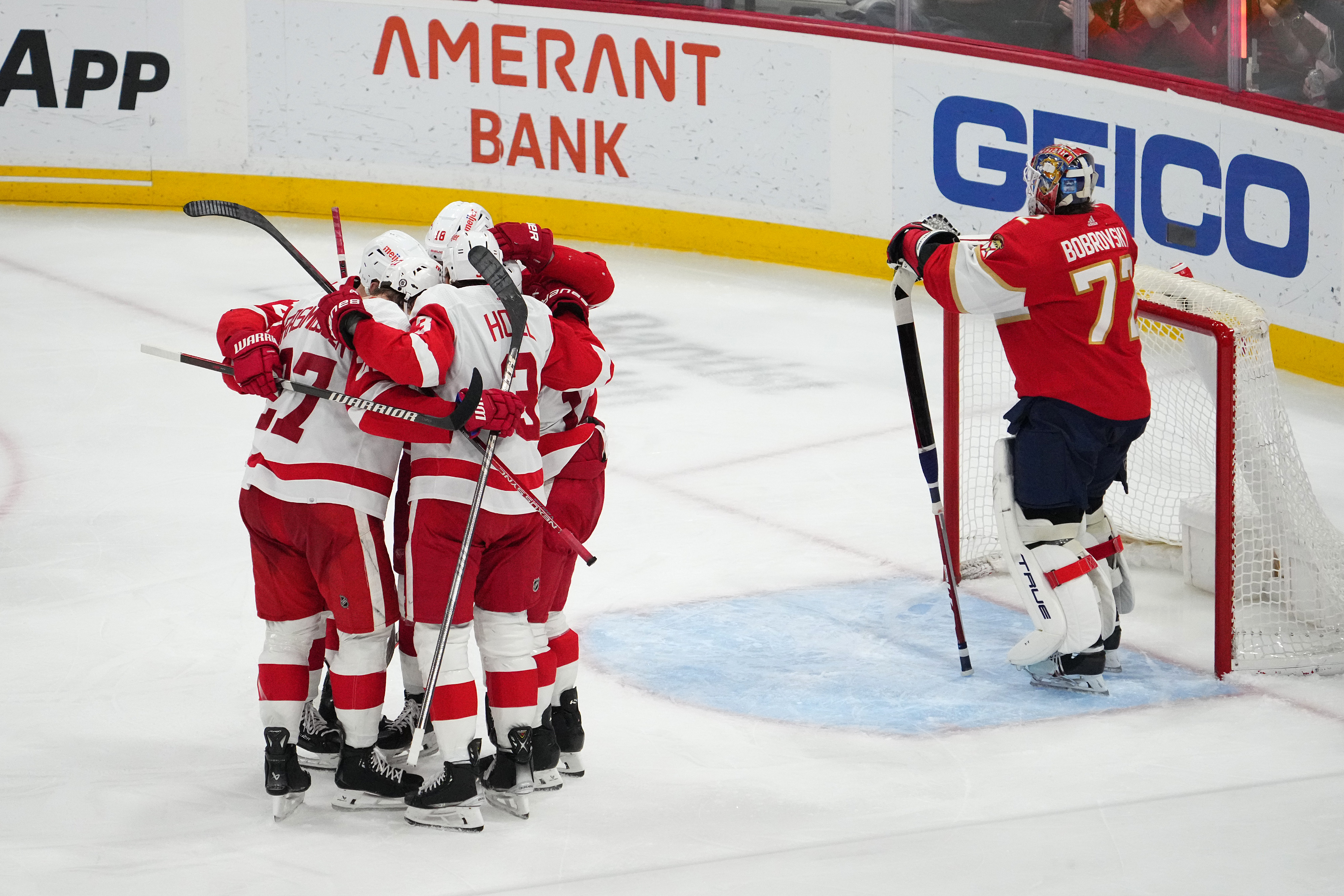
In a season of jagged peaks and valleys, the Red Wings' 2024 heater solidifies their fortitude and status as credible postseason contenders
In a season of jagged peaks and valleys, the Red Wings' 2024 heater solidifies their fortitude and status as credible postseason contenders

As the new year began, the Detroit Red Wings had no misconceptions about the challenge before them.
After all, it was their performance in the preceding month that rendered the run-in to the All-Star break and the first weekend of February a season-defining stretch. Either the Red Wings would fade into mediocrity (or perhaps worse than that), or they would validate the good feelings they evoked in the season's early days and reaffirm the plausibility of their playoff aspirations.
"Everyone's aware of what's going on and where we are, where we put ourselves from December," said captain Dylan Larkin after a January 13th win over the Los Angeles Kings. "We had a tough, tough stretch there before Christmas, and we had a great trip out west, came home and played hard against Edmonton, and then that was one of better performances tonight, so it's great to see."
December was dismal for Detroit: a 5-9-1 record, a .367 points percentage, and a -14 goal differential. Injuries to players like Larkin, J.T. Compher, Alex Lyon, and Ville Husso provided pertinent context, but even then, the haplessness of the Red Wings' defensive efforts during that stretch—the frequency with which opponents were left wide open in premium scoring positions—left thoughts of the postseason somewhere between futile and laughable.
But that was then, that was last year, and in 2024, Detroit is 6-0-1, having picked up points in each of its seven games. Five of those games came against opponents who would qualify for the playoffs if they began today. It's taken just two weeks for the Red Wings to propel themselves from a sense of 'here we go again' back to the thick of the playoff race.
Last night's overtime win in Florida is perhaps the best illustration of how Detroit has swung its fortune. Against a Cup contender who had beaten them 10 consecutive times, the Red Wings ground out a 3-2 result on the road.
Larkin clinched the game with a 4-on-3 power play goal in overtime, but it was the team's third line of Andrew Copp, Michael Rasmussen, and Christian Fischer who'd gotten them there.
"They're playing at a high level, but it's just simple," said Lalonde of the trio that produced both regulation goals for his team last night. "They're playing north. They're working off the forecheck. They're spending time with the puck in the O zone. They're winning the field position battle. The ice is tilted when they're out there.
Rasmussen got Detroit on the board in the second, then it was his feat of puck protection below the goal line that allowed him to feed Robby Fabbri in the slot for the goal. To Lalonde's point, it was a triumph of simplicity and hard forechecking but also of selflessness and sacrifice.
As the Red Wings settled into an extended offensive zone possession, Fischer went to the bench for a change, a textbook example of winning hockey at the sport's highest level. That decision set the stage for Fabbri, who replaced him, to score the equalizer.
"It's been the story of our little run here: When the chips are down, we just find a way," said Lyon after the game. "Some nights it's not going to be perfect, but as long as we keep that effort, that battle, and that resilience, good things are going to happen."
While the results have been exceptional of late, Detroit's largest margin of victory in its recent heater is two.
Back in October (a month the Red Wings finished at 6-3-1), Detroit might have been a higher flying team—explosive to a degree no one anticipated, but there was always something too good to be true about those heights. A 12.9% shooting percentage and a 32.4% power play conversion rate were never going to last.
The margins are much thinner now, but the style in which the Red Wings have achieved those margins looks much more like playoff hockey than the "out-scoring problems" approach that powered them to a hot start.
Of course, if there's anything this season of ebbs and flows has taught us, it's that good fortune can turn foul in a hurry. A five-game win streak in October preceded a run of four losses in five. Winning seven of eight after returning from Sweden in late November came before a run of seven defeats in eight games.
There is still nearly half a season's work left to do, even as Detroit has aced the test it set out for itself at the start of the month. Having sat in a playoff spot in mid-January will be little comfort if the Red Wings find themselves on the outside looking in come April.
Nonetheless, in a season of jagged peaks and valleys, the Red Wings have made one thing clear: however long they might spend in the darkness, they will find light on the other side.
Also from THN Detroit
"When the Chips Are Down, We Just Find a Way": Lyon, Larkin, Lalonde React to OT Win in Florida
Sunday's Red Wings-Lightning Moved to 7PM to Accommodate Lions' Divisional Round Playoff Game
Injury Update: Patrick Kane Will Be Unavailable Through Southern Road Swing
Red Wings, Toledo Walleye Announce a Three-Year Extension to Affiliation Agreement
Has Alex DeBrincat Been the Red Wings Best Player This Season?
Injury Update: Patrick Kane's Injury Not Believed to Be Hip-Related
Red Wings 5, Kings 3: Late Second Period Surge Powers Detroit Past Visiting Kings
